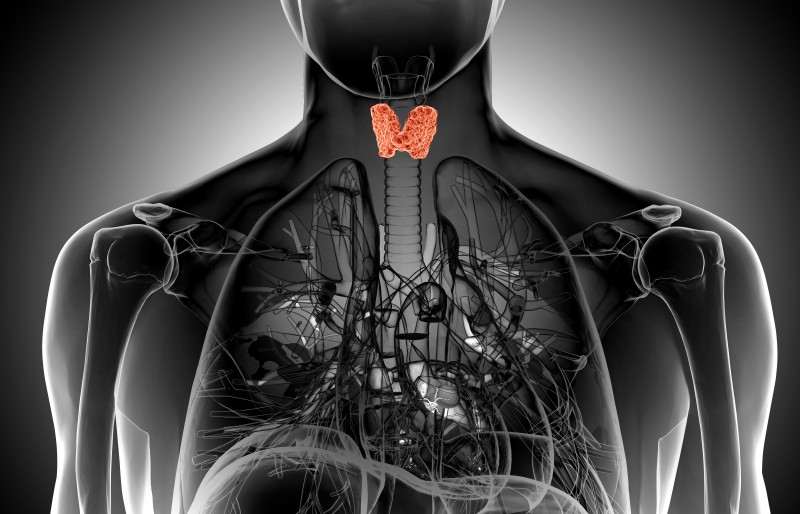
There are few things in life with a stronger association than the hormone testosterone and the strength-power athlete community. This T-molecule is known for strength, hypertrophy, power, and performance in bodybuilding, powerlifting, weightlifting, and strongman.
This is a fair association, given its ability to alter physiques and abilities under the bar. It is not uncommon for athletes to seek out diet and training regimens to optimize this hormone or shop for the latest test booster, adaptogen, or in some cases, performance-enhancing drugs to enhance testosterone. But what if there was more than just one powerful “T” driving our internal health and performance?
From a physiological perspective, there are few, if any, hormones more influential than thyroid hormones, especially for athletes. Thyroid hormones not only serve as an energy regulator but as a barometer of the influence that stress has on our bodies, whether that be training stress, nutritional stress from a caloric deficit, or stress derived from our daily lives.
RELATED: The Thyroid — Regulator of Your Metabolic Fate
The thyroid gland is the main metabolism gland in your body, and it is an integral part of the endocrine system. If your thyroid is not working correctly, you will have a difficult time achieving your desired body composition, and you may also see a cascade of additional hormonal issues not exclusive to the thyroid. In the end, as you can see, the thyroid is an important gland. It is also a very sensitive gland in a regulatory sense when it comes to food consumption, activity, and stress.
For strength sports applications, this means influencing our total food consumption and the amount of energy we feel we have to set PRs and go about daily tasks. When operating properly, the thyroid gland produces the thyroid hormones triiodothyronine (T3) and thyroxine (T4), which regulate many processes in our bodies, primarily hormonal balance, protein synthesis, and metabolic rate.

tagota © 123rf.com
To provide some context of the prevalence of thyroid hormones and their receptors: Every cell in the body has receptors for thyroid hormones, from bone and liver cells to brain and immune cells. The only other hormone that has receptors on every cell membrane is Vitamin D. When we think of this from a 10,000-foot perspective, this makes sense given the need for our body to perceive light and external energy for circadian rhythm but also external energy in the form of calories available from food (thyroid regulation).
Thyroid hormones are analogous to keys for our homes, and the receptors to match are door locks. Reasons thyroid hormones and their respective receptors are so important include:
- The relationship of thyroid hormones to reproductive hormones and steroid hormones; and
- The prevalence and sensitivity of thyroid receptors across the body.
In men, thyroid receptors exist in Leydig cells, which are the main testosterone-producing cells in adult males. Thyroid hormones and their receptors play an important role in stimulating the cells and proteins that regulate the transfer of cholesterol to make steroid hormones like testosterone. This is why it is not uncommon to see athletes with hypothyroidism have low testosterone and vice versa.
Additionally, thyroid receptors exist in ovarian cells in women. With such close proximity to a women’s reproductive center, thyroid hormones can play an important role in menstrual cycle regulation and maintenance. This is often why you see competitors who experience prolonged caloric deficits suffer from anovulatory cycles (irregular cycles), amenorrhea (absence of cycles), or fail to ovulate each month. It also explains how overtraining can lead to loss of regular cycle health for women through influencing our reproductive hormones as a means of additional energy conservation. We also see changes like a drop in body temperature and even hair loss.
Aside from misunderstanding the level of importance of thyroid hormones, one of the biggest areas of confusion is the distinction between T3 and T4. Thyroxine, or T4, is produced by the thyroid and must be converted through enzymatic actions (subtracting an iodine molecule) to create T3 — our metabolically active thyroid hormone. Most of this conversion takes place in the gut and the liver and is influenced by our cumulative burden of stress on the body, whether it be a nutrient deficiency, training demands, lack of sleep, or otherwise.
For the most part, T4 to T3 conversion runs smoothly, and our metabolically active T3 hormone is able to act on receptors (mentioned above), but certain medications, infections, autoimmune conditions, inflammation, and cumulative stress can throw a wrench in an otherwise seamless process.
Given the importance and prevalence of this “other T,” it can be important to develop tactics for tracking and monitoring thyroid hormone health. Coaches and individuals can monitor elements such as basal body temperature, daily NEAT (steps), appetite, and daily energy as a part of measuring progress outside of the typical measurements and progress pictures.

The old adage “the best time to plant a tree was years ago, the second-best time is today” rings true for thyroid health. If you aren’t already conscious of your internal health and physiology, consider taking inventory and action on the following items:
- Reducing inflammation: Inflammation causes an uptick in corticosteroid production to create the metabolite cortisone. Corticosteroid-releasing hormones can negatively inhibit the production of thyroid-releasing hormones from the hypothalamus and also negatively impact the conversion of T4 to T3 in the body, which primarily occurs in the gut and the liver.
- Removing dietary triggers that promote intestinal permeability and eliminating foods to which clients are sensitive: Gut issues are just one example of internal health stressors that can signal the body’s inflammatory response, such as the corticosteroid cascade mentioned above.
- Customizing diets according to your or your clients’ unique needs: Remember that thyroid hormones and physiology as a whole are adaptive. More or less food, exercise, sunlight, and environmental exposure can all influence our total daily energy expenditure.
- Maximizing nutrient density: Iron, zinc, tyrosine, iodine, selenium, and Vitamins E, B2, B3, B6, C, and D are all important for thyroid health.
- Periodizing nutrition: You wouldn’t randomize your lift selection prior to a powerlifting meet, and you shouldn’t roll the dice on your nutrition, either. Plan intentional periods of caloric deficits, maintenance, and surplus to ensure not only optimal thyroid output but also sensitivity to thyroid hormones. Long-term or chronic caloric deficits are the enemy here.
- Reducing toxic exposures: Mercury, cadmium, lead, and some pesticides may have a negative impact on thyroid health.
- Stabilizing blood sugar: This is especially important for anyone with a family history of diabetes or thyroid health issues.
- Consider an interval diet: Consider a staggered or stair-step approach to dropping calories, especially if embarking on a longer weight loss journey such as moving up or down a weight class. The MATADOR protocol showed greater total fat loss in a group of men who followed a two-weeks-on, two-weeks-off approach to energy restriction (calorie deficit) at 67 percent of their maintenance calories, the rationale being that the staggered approach prevents adaptations or down-regulation in metabolism from chronic dieting.
- Get tested: The best metrics are TSH, Free T3, Reverse T3, Total T3, Total T4, Free T4, and TBG. If you suspect an autoimmune disease, consider getting your antibodies checked (this is typically more prevalent in women).
Your “other T” levels might just be the root of untapped fully optimized performance. A little bit of tracking and intelligent programming can go a long way in ensuring your thyroid function is at maximal potency.
References
- Sheue-Yann Cheng, Jack L. Leonard, Paul J. Davis, Molecular Aspects of Thyroid Hormone Actions, Endocrine Reviews, Volume 31, Issue 2, 1 April 2010, Pages 139–170, https://doi.org/10.1210/er.2009-0007
- Toni R. 2000 Ancient views on the hypothalamic-pituitary-thyroid axis: a historical and epistemological perspective. Pituitary 3: 83-95.
- Dyess EM, Segerson TP, Liposits Z, Paull WK, Kaplan MM, WU P. Jackson IMD, Lechan RM. 1988 Triiodothyronine exerts direct cell-specific regulation of thyrotropin-releasing hormone gene expression in the hypothalamic paraventricular nucleus. Endocrinology123:2291-2297.
Sam Miller has seen both sides of the spectrum when it comes to health and physique development, from troubles in his own health journey to competing as an athlete, coaching, and speaking across the country for fitness professionals and corporations alike. In addition to serving as a training and nutrition coach, Sam has a passion for helping other coaches correct their clients' endocrine and metabolic issues. He also teaches a men's health master class for Nutritional Coaching Institute to explain how this is possible through diet, exercise, and supplementation strategies. You can learn more about Sam and his applied science methods @sammillerscience on Instagram and at sammillerscience.com.











1 Comment